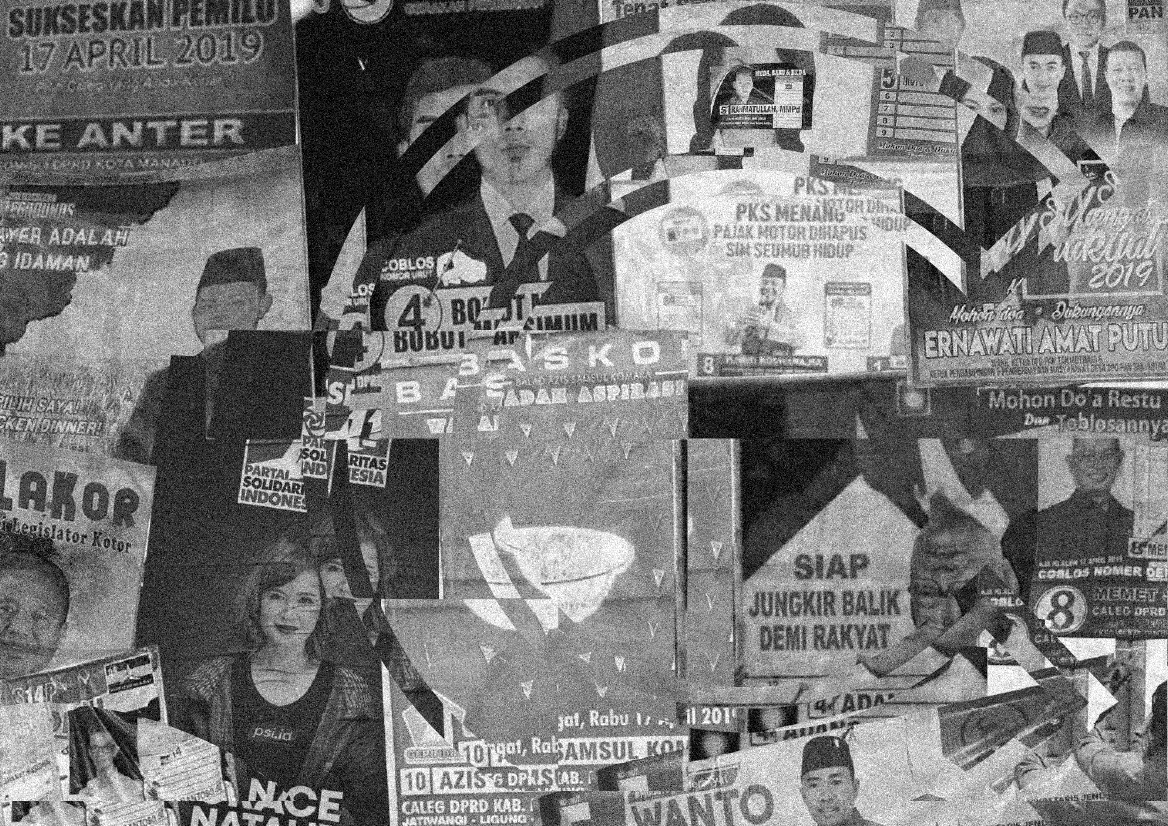
Dear Politicians, We Are Tired of Your Ugly Electoral Poster Design
In this Open Column submission, Aisyah Madeleine reflects on the ever-polluting electoral campaign poster designs and how such practices captured public fatigue about the candidates’ artificial smiles and their unclear political messages.
Words by Whiteboard Journal
It’s less than two months until Indonesia’s election day, and as I passed the third intersection of the day, I was exposed to at least 30 electoral campaign posters on my way home. I couldn’t help but notice that almost all of the posters tick every box needed in our politician’s idea of an “effective” campaign poster design.
These posters usually consist of three arguably eyesore-inducing visual elements: overly saturated portraits of the bright-eyed candidates with their respective religious attributes, name and legislative number zoomed in on the voting paper, and the dominant color from affiliated parties along with the party leader’s photo looming over them.
Here’s how I’d personally score them to have fun in between traffic jams: bonus points for catchy slogans, jokes, or wordplay; “you tried” stickers for younger candidates trying the minimalistic design with semi-candid portraits; minus points for using AI art in any form; and a rare smiley face for any form of unique propositions regarding specific policies or issues.
So let me take you on a quick journey to answer my itching questions: First, as a designer and communications person myself: “Is this the only design trope that works? Is it even an effective campaign effort?”. Second, as an overthinking lower middle-class constituent and voter: “Can we genuinely trust our future to be guided solely by their smile, name, and voting number? What does this say about us, as the public and the nation?”
Making sense of the trope
Turns out, the display of our representatives’ glaring portraits can be traced back to ancient Rome. In 49 BC, when money was the only available medium for everyday people to know their leader, Julius Caesar decided to mint his face on Roman coins to make his faraway constituents familiar with him as the absolute ruler of Rome. Adopting the same method, Emperor Commodus pushed out his own coin with regal symbolism by wearing a lion skin headdress, along with attribution to mythology (in this case, Hercules) to build the image of greatness and authority.
Fast forward to Indonesia today, I see that the figure of Hercules is replaced by prominent political party figures who are often former President’s sons or daughters—no matter how problematic they are. The regal symbolism to show authority is now represented by the candidate’s portrait wearing ethnic or religious attributes and education titles, tailored to resonate with specific demographics in specific regions. Within seconds, we could tell who backed this candidate and the identity they represented. This might seem effective, but ultimately the constituents are left with nothing but a name and the vaguest idea of their stance.
This leaves us with the last visual aspect to somehow predict a candidate’s stance from the posters: the political party’s identity. President Soeharto’s suggestion in 1970 to group political parties based on ideologies—nationalist, spiritualist or religious, and functional groups—shaped a tendency among the public to rely on colors and symbolism to get a sense of direction for the policies these parties would form.
Simply put, if I were a 48-year-old Balinese-Hindu middle-class housewife living in Tabanan, I’d gravitate towards the color red or blue (mainly nationalist parties), since it’s unlikely that the color green or orange (mainly Islamist religious parties) would understand or serve my needs. These simple primary colors manifest as identity politics, when in reality, the dynamic between political parties and policy-making is rarely that simplistic. I’m privileged enough to learn that reality by working on bijakmemilih.id since late last year.
The safe, t̶i̶r̶e̶d̶ tried and true design approach could also be the result of the 1955 election, when there were no campaign regulations and black campaigns were everywhere. It was deliberately provocative, where the posters are focused on clashing each other’s ideologies instead of their programs. But now, there are rules to be followed.
Today’s campaign regulation from KPU (The General Elections Commission) stated that the campaign material must be conveyed in a way that is: a) Polite, that is, using appropriate language or sentences polite and appropriate to appear in public; b) Orderly, that is, not disturbing the public interest; c) Educational, that is, providing useful information and educating voters; d) Wise and civilized, that is, not attacking individuals, other groups, factions or candidate pairs; and e) Not provocative.
Having these backgrounds in mind, then adding logistical constraints (campaign budget and deadlines, administrative requirements, and politics in general), I’m starting to reluctantly understand that most of these candidates are merely relying on an easy, familiar effort. The design itself might not even be relevant if they aim for quantity over quality. After all, no matter how it looks, as long as the amount of posters are 10x more than the other candidates and placed strategically, people might remember it better.
Spinning the common thread between design, democracy, and status quo bias
As far as I can think of, this design trope and other common campaign practices might somehow work in the candidates’ favor, but absolutely not in ours, as constituents.
Right now, there could be more than ten legislative candidates for one region. Assuming that each candidate aims for quality over quantity, there would be at least 50 banners for one region (and I’m not even going to touch how advertisement tax rules seem to be gone during the campaign period). Even if we include the problematic party identity color-coding method as an elimination system for voters, it would be a miracle to remember a single name or number. It is so far from the ideal well-informed choice based on aspects that actually matter, like track record and important causes for each candidate.
Apart from the design, the banners’ installations came with a lot of problems that came with our cost: taking away pedestrian space, damaging trees and electric poles, and polluting not only our visuals but also the environment. The material used for these billboards and banners is usually PVC paper, which is a high-strength thermoplastic material. Even though this material is recyclable, if these candidates wouldn’t even invest in the quality of the campaign itself, I highly doubt they would invest in its responsible waste management.
The funny thing is, better common practices are not even hard to find. Japan’s electoral campaign regulation has strict and clear rules regarding poster placements, size, and number. Their use of Keijiban or community bulletin boards might be more effective since they’re usually placed in high-traffic public areas like train stations. Design trope-wise, the Singapore Democratic Alliance managed to stand out from the rest of the other parties in 2020 thanks to their nostalgic, illustration-heavy retro poster design that represents their current social issues, which conveys a clear political message.
This situation seems, to me, like status quo bias at its finest. Despite the obvious negative impacts and the lack of measurement, whether we want it or not, we have to endure these questionable campaign practices every five years. Fun fact: this trope has been sitting right in front of our eyes for almost 20 years since the 2004 election. I can’t help but feel defeated and entertained at the same time by the baffling idea of our representatives’ unwillingness to change, the sheer faith to rely on the same old trick, yet promising progress and difference in every chance they have.
From my eyes, this tired and problematic electoral poster design trope captured how tired the public is and how problematic Indonesia’s democratic system is. We are tired of seeing the same premise with little to no progress. We are tired of seeing empty smiles only to be piled with more problems. We are tired of being reduced to mere numbers and casualties for the sake of the oligarch’s ambition.
At the end of the day, it is pretty clear that our current system makes great design and communication efforts seem like a luxury. While I know that public participation requires effort on our part, can we at least hold our representatives to one single accountability: a constituent-centric poster, filled with the right information, distributed in the right place, and at the right amount?




